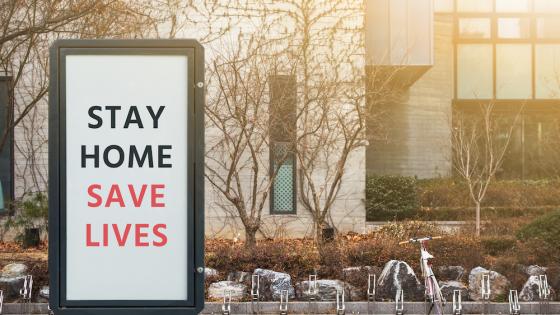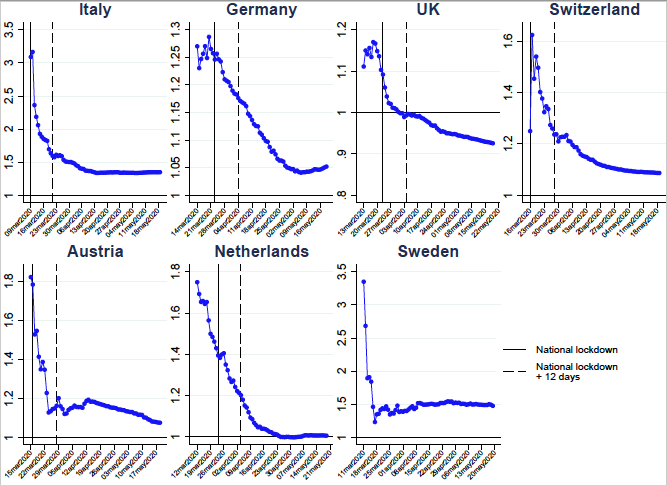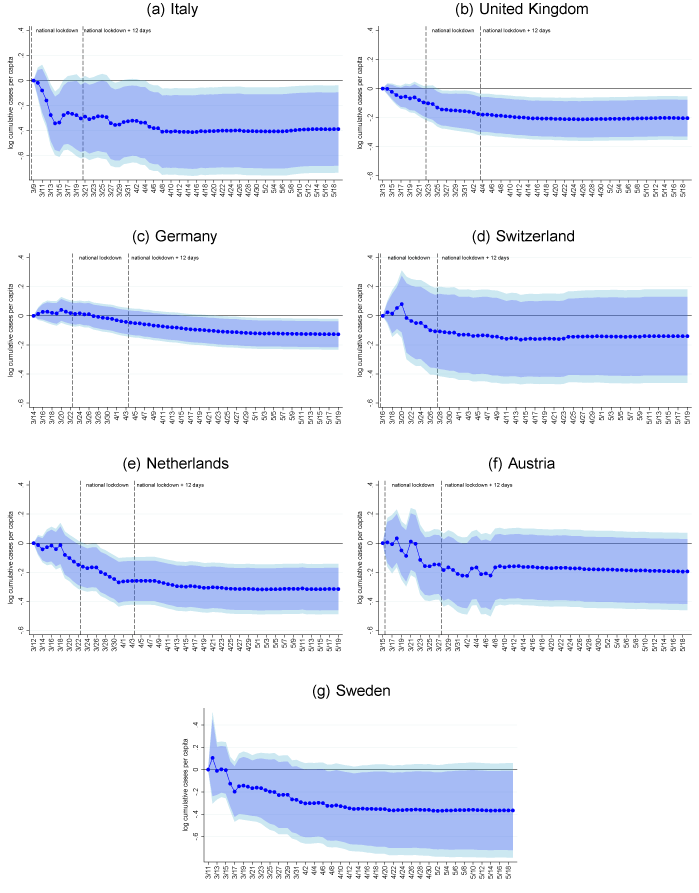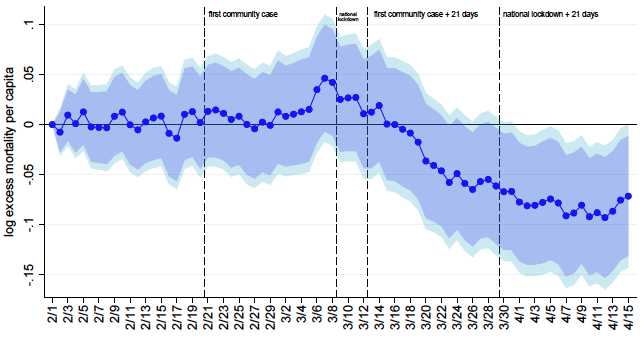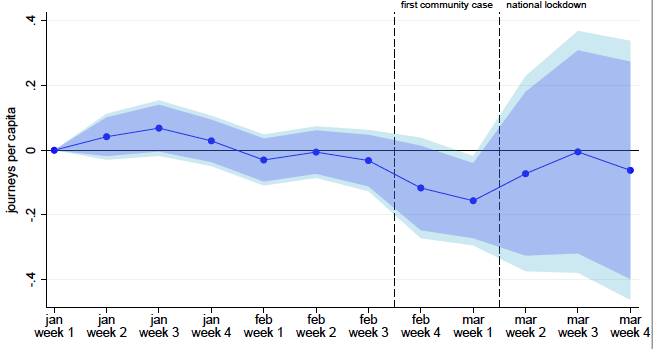Since the beginning of this year, the novel coronavirus has spread rapidly, turning into one of the greatest healthcare and economic crises of our time that is affecting the lives, health outcomes, and livelihoods of people around the globe. With no medical solution available yet, the key margin to contain the spread of the pandemic is human behaviour, i.e. willingness to practice ‘social distancing’ (Van Bavel et al. 2020, Baldwin and Weder di Mauro 2020). Consequently, policymakers and health experts around the world have asked their populations to limit social contacts and follow strict hygiene and distance recommendations, appealing to the social responsibility of their citizens. For example, Giuseppe Conte urged that “the responsible conduct of every one of us will be fundamentally important ... If you love Italy, keep your distance”. This willingness to act collectively and pursue socially valuable goals is commonly referred to as social capital (Putnam 1993, 2000).
While social capital plays a key role in official Covid-19 strategies around the globe, there is no systematic evidence on whether it is indeed an important factor in containing the spread of the virus. Our recent study (Bartscher et al. 2020) adds empirical evidence to this timely question by analysing the relationship between social capital and the early spread of the virus. We independently investigate the relationship in seven European countries – Austria, Germany, Italy, the Netherlands, Sweden, Switzerland, and the UK – exploiting within-country regional variation in the spread of Covid-19 and social capital. As countries differ in many macroeconomic and Covid-19-specific aspects, we mainly focus on exploring the relationship within each country (Goodman-Bacon and Marcus 2020).
The role of social capital
From a theoretical point of view, social capital, the spread of Covid-19, and containment policies interact in various ways. High social capital is associated with higher social responsibility, but areas with high social capital are also known to be more socially active, vibrant, and better connected (Knack and Keefer 1997, Tabellini 2010). Therefore, one would expect the virus to spread faster in those areas at the onset of the pandemic (a stage when information about the virus and its severity was not yet public knowledge). However, as soon as the importance of behavioural ‘containment’ norms becomes more salient, one would then expect these areas to adopt voluntary containment measures (social distancing) more rapidly, leading to a relative decrease in new infections. Finally, when the strictness of official containment policies is increased (e.g. via a national lockdown), non-compliance can be more easily detected and sanctioned. Hence, we would expect containment to depend less on social capital during stricter policy regimes in a later phase of the pandemic.
Early stages: More Covid-19 cases in areas with high social capital
Figure 1 plots cumulative per-capita Covid-19 cases over time in areas with high social capital compared to those with low social-capital areas. We operationalise social capital by area-specific electoral turnout in the 2019 European election, a consistent and comparable measure across countries mostly unaffected by economic factors (Putnam 1993, 2000).1 Across all countries, we observe that the virus is initially more prevalent in areas with high social capital. This observation is in line with our first hypothesis. Starting from this high initial level, we see a sharp decline in the ratio in the following weeks, i.e these areas accumulate relatively fewer cases per capita. Over time, the differential drops until areas with high and low social capital have almost the same number of cumulative cases per inhabitant. Strikingly, the decline starts before national lockdown policies could have started to have an effect (due to incubation time and reporting lags). This is a first indication that voluntary socially responsible behaviour may play a role in the containment of Covid-19.
Figure 1 Ratio of cumulative Covid-19 cases per capita in areas of high versus low social capital
Note: The sample is divided at the median of turnout at the NUTS1 region level, where above-median turnout levels are defined as areas with high social capital. The blue lines plot the population-weighted average of the regional ratios over time. The solid black line marks the date of the national lockdown, the dashed black line the date of the national lockdown plus a 12-day incubation time.
Differences in infection dynamics
While the descriptive evidence presents simple correlations over time, we implement a more rigorous empirical model to study the evolution of the relationship between social capital and the spread of the virus in each country systematically. In each country, we regress the daily log cumulative Covid-19 cases on a measure of pre-determined social capital, interacted with ‘daily fixed effects’. We include a battery of fixed effects to flexibly control for regional outbreak patterns, differential outbreak dates, and time-contingent spread patterns.
Figure 2 visualises our main findings. The presented coefficients compare the evolution of log cumulative cases in areas with a higher social capital against areas with a lower social capital over time.
Figure 2 Relationship between cumulative Covid-19 infections per 100,000 inhabitants and social capital across time
Note: Values are normalised at the date of the first observation. The first dashed line marks the date of the national lockdown, the second dashed line the date of the national lockdown plus 12 days (incubation + confirmation time).
Across all countries, we see a similar pattern: areas with high social capital exhibit a slower growth in cumulative cases than areas with low social capital. This reduces the number of cases they accumulate over the considered period by between 12% (Germany) and 32% (Italy). Countries with a loose lockdown (e.g. the Netherlands) or no lockdown at all (e.g. Sweden) show effects which are in the ballpark of Italy. In our paper, we show that results are robust to potentially confounding variables, such as GDP, educational attainment, population size, the share of elderly residents, the share of ‘white-collar’ workers, the number of hospitals, or population density. Furthermore, our results also hold for alternative measures of social capital such as blood donations and historical literacy rates.
Overall, we interpret the consistent pattern obtained from independent analyses of seven countries as strong evidence in favour of the hypothesis that social capital plays an important role in slowing down the spread of the virus.
The Italian case: Excess mortality and mobility
For our case study, we focus on Italy, which was the first European country to be massively affected by the virus, finding both government and citizens unprepared. We consider two alternative outcomes: excess mortality (Ciminelli and Garcia-Mandicó 2020a, 2020b) and mobility based on mobile phone location data.2
Figure 3 shows results for excess mortality. By mid-April, a one standard deviation increase in social capital (i.e. turnout) is associated with 7% fewer accumulated excess deaths. The observed dynamics corresponds well with the pattern observed in Figures 1 and 2. Excess mortality drops in high-social-capital areas approximately two to three weeks after the first community case was discovered, which is in line with (preliminary) evidence that deaths tend to occur around three weeks (21 days) after the infection (Yang et al. 2020).
Figure 3 Estimated effect of social capital on log number of excess deaths per 100,000 inhabitants (additional deaths in 2020 compared to 2019) from 01 February 2020 to 15 April 2020
One of the main mechanisms through which social capital might affect the spread of the virus is individual mobility (Askitas et al. 2020). The results for mobility (Figure 4) mirror the dynamics of excess mortality. Up until the end of February (the time of the first community case), there is no visible difference in mobility. At the onset of the pandemic, mobility in areas with higher social capital declines significantly more than lower social capital areas. This differential vanishes after the national lockdown is enforced. In terms of magnitude, we find that a one standard deviation increase in turnout decreases mobility by 0.16 journeys per capita (in the first week of March). This amounts to a 15% reduction, relative to the average pre-Covid mobility. This magnitude is comparable with the estimates in Durante et al. (2020), who study the differential mobility responses in Italy across different quartiles of the social capital distribution.
Figure 4 Estimated effect of social capital on individual mobility (weekly number of journeys per capita)
Concluding remarks
Our results demonstrate the role of social capital in the successful containment of a population during a public health crisis. Areas with high social capital seem to be better able to contain the virus compared to low-social-capital areas, even absent any lockdown policy. While this finding has immediate effects on health and deaths, it could also affect the size of the economic downturn and recovery (Barro 2020, Barro et al. 2020).
In the light of possible future waves of Covid-19, our findings have direct implications for policymakers when determining the strictness of containment policies. As regional turnout is easily observable, it could be used as a target by local policymakers when assessing the trade-off between the economic consequences of a lockdown versus the health risks. The recent policy shift in Germany, which delegated more responsibility to the county level, might be a good way to allow for this regional flexibility.
In the longer run, investing in social capital formation is an important insurance against similar future pandemics. The insights from our study mandate policymakers to invest not only into the healthcare system, but also into social capital formation to be well-prepared in the future.
References
Askitas, N, K Tatsiramos and B Verheyden (2020), “Flattening the COVID-19 curve: What works”, VoxEU.org, 5 June.
Baldwin, R and B Weder di Mauro (2020b), Mitigating the COVID economic crisis: Act fast and do whatever it takes, VoxEU.org eBook, CEPR.
Barro, R J (2020), “Non-Pharmaceutical Interventions and Mortality in U.S. Cities during the Great Influenza Pandemic, 1918-1919”, NBER Working Paper 27049:.
Barro, R J, J F Ursúa and J Weng (2020), “The Coronavirus and the Great Influenza Pandemic: Lessons from the "Spanish Flu" for the Conoravirus’s Potential Effects on Mortality and Economic Activity”, NBER Working Paper 26866:.
Bartscher, A, S Seitz, S Siegloch, M Slotwinski and N Wehrhöfer (2020), “Social Capital and the spread of Covid-19: Insights from European Countries”, CEPR Discussion Paper No. 14711.
Ciminelli, G and S Garcia-Mandicó (2020a), “COVID-19 in Italy: An analysis of death registry data”, VoxEU.org, 22 April.
Ciminelli, G and S Garcia-Mandicó (2020b), “COVID-19 in Italy: An analysis of death registry data, part II”, VoxEU.org, 19 May. https://voxeu.org/article/covid-19-italy-analysis-death-registry-data-pa...
Durante, R, L Guiso and G Gulino (2020), “Civic Capital and social distancing: Evidence from Italians’ response to COVID-19”, VoxEU.org, 16 April.
Goodman-Bacon, A and J Marcus (2020), “Using Difference-in-Differences to Identify Causal Effects of COVID-19 Policies”, Survey Research Methods 14(2): 153-158.
Knack, S and P Keefer (1997), “Does Social Capital Have an Economic Payoff? A Cross-Country Investigation”, Quarterly Journal of Economics 112(4): 1251-1288.
Putnam, R D (1993), Making Democracy Work: Civic Traditions in Modern Italy, Princeton, NJ: Princeton University Press.
Putman, R D (2000), Bowling Alone: The Collapse and Revival of American Community, New York: Simon and Schuster.
Tabellini, G (2010), “Culture and Institutions: Economic Development in the Regions of Europe”, Journal of the European Economic Association 8(4): 677-716.
Van Bavel, J J, K Baicke, P S Boggio et al. (2020), “Using Social and Behavioural Science to Support Covid-19 Pandemic Response”, Nature Human Behaviour 4(5): 460-471.
Yang, X, Y Yu, J Xu et al. (2020), “Clinical Course and Outcomes of Critically Ill Patients with Sars-Cov-2 Pneumonia in Wuhan, China: A Single-centered, Retrospective, Observational Study”, The Lancet Respiratory Medicine 8(5): 475 –481.
Endnotes
1 Since Switzerland is not a member of the European Union, we use turnout data from the most recent national election held in October 2019
2 Mobility data are provided by Teralytics, a Swiss company that collects data on cell phone locations from Italian cell phone providers
